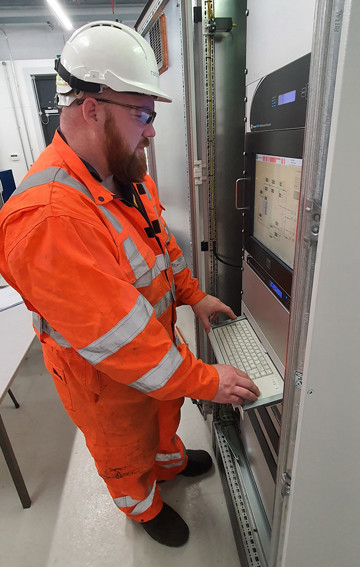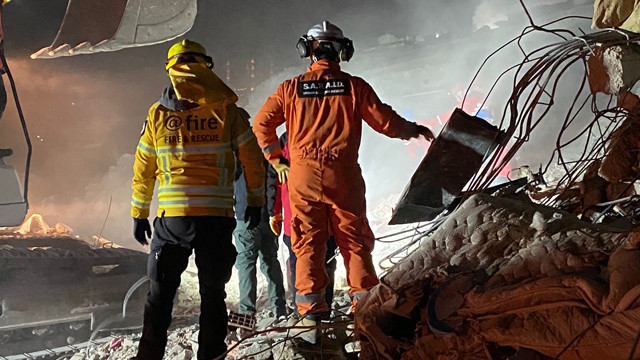
Substation engineer joins the rescue work in earthquake-hit Turkey
Imagine going to bed expecting to head into your usual work the next day but you are woken up at 5:30am by a call that means your day – and indeed your week ahead – takes a significantly different turn. This was what happened to David Jones, a substation engineer in National Grid Electricity Transmission and also an emergency rescue volunteer, earlier this month.
Within hours, David was packed up and en route to Turkey, part of a UN-approved disaster recovery team of 20, to carry out 'search and rescue' for victims of the once-in-a-century magnitude earthquake that hit both that country and Syria on 6 February. Here he shares his experiences and the realities of being part of a volunteer international search and rescue group, including on his most recent mission to Turkey.

First, tell us about your ‘day job’
I joined National Grid in 2012 as part of its apprentice scheme and I’m now a Substation Engineer in Sussex. My role is to help carry out maintenance and fault finding on the high-voltage electricity network, keeping the network running smoothly.
And your ‘off the clock’ activity?
Since 2017, I’ve been part of SARAID UK (Search and Rescue Assistance in Disasters); we're the first and only UK voluntary team to be officially classified by the United Nations’ international search and rescue group as a light USAR (Urban Search and Rescue) team. We’re 100% volunteers and receive no government funding or Disasters Emergency Committee (DEC) funding for the work we carry out.
The team is comprised of emergency managers and planners, engineers and paramedics. It includes specialists in the fields of structural engineering, water and rope rescue, collapsed building rescue, logistics, hazardous materials, communications and technical search.
How did you get involved in this?
I used to be part of Lowland Rescue covering the Home Counties, but I felt the opportunity to help people around the world on a larger scale in their time of need was something I could not pass up.
Tell us about the mission to Turkey earlier this month
As a United Nations team, we automatically receive alerts of major disasters around the world and our first alert about the earthquake was in the early hours of Monday morning. As a voluntary non-government team, we have to be invited to attend by the host government where the disaster has happened, so as not to overwhelm them with incorrect support.
The initial request was just for medical assistance. However, as the disaster unfolded over the next few hours and the second major earthquake hit, it was clear a full international response was required; including all classifications of urban search and rescue (USAR), medical and relief aid teams, and government-level help. We knew it was a case of ‘all hands on deck’ and to start readying for deployment.
My first call was at about 5:30am and I had my kit packed and was en route to our stores by lunch time, with managerial approval.
On this occasion, we flew from Stansted Airport to Adana via Istanbul on a civilian flight. Part of the reason for flying via a normal charter flight, despite having 20 people and over 2 tonnes of equipment, was that the local military airports in Turkey had been closed down due to runway damage, as they're nearer the epicentre. It was the quickest and easiest way to fly but we did have some limitations on seat availability, so the team and kit was spread over three flights, the first leaving in the small hours of Tuesday morning.
What were your first thoughts and impressions on arrival?

Silence … when we first left the airport it was dark and there wasn’t much damage in the surrounding areas. However, once we got on the bus and moved towards Kahramanmaraş our team bus fell silent with, to be honest, the odd expletive as we got closer to the city. The devastation was far greater than any of us expected, even those that have been doing this 20-plus years. Once we got off the bus we were thrown straight in at the deep end to relieve a partner team that was in the middle of a rescue, which is where the training took over. In your head you take a step back from what is all around you and you focus on the recovery in front of you and the buildings.
How long were you there and what were the practicalities like?
The team was 'in country' for a total of seven days, which was the duration that the USAR efforts we were required for. The larger teams have carried on now and moved onto the next stages of recovery, which needs a different set of skills to ours.
We’re fully self-sufficient; we take all our own water, ration packs and sleep in tents, despite the -7°C cold recorded in the camp overnight. If there is a suitable hotel or building to sleep in, we'd rather this be given to the locals whose need is much, much greater than ours. This was the same situation for other locations around Turkey; pop-up tent cities of teams from around the world, working together.
Can you share how you do the work?
Our main way of finding people buried below tons of concrete is a system called Delsar. This involves ultra-sensitive listening microphones that can pick up even fingernails scratching under several stories of collapsed building. We place these sensors in and around the building onto the most solid surfaces we can find. We then initiate a 'call and response' by knocking and shouting to see if we can hear someone responding to us.
We can also hear the likes of mobile phones ringing and being answered, which happened in Turkey. Once we hear something, we move the sensors around to pinpoint where the noise is the loudest and this will direct us to where to start breaching into the building, using tools like petrol disc cutters, drills, jack hammers, diggers and the humble hammer and spade.
We're also extremely fortune to have a first look ‘360 camera’, which lets us look and listen into a void in full 360 degrees. Some of the footage taken from our camera, looking into a void where a trapped person grabbed the camera seeing the light, has been shown on news channels all round the world. This particular one turned out to be a mother and child, who I’m pleased to say we recovered, both fit and well.
Watch the moment when a trapped person grabs the team's search camera.
What other disaster situations have you attended to assist at?
This was my first earthquake deployment. In the past I’ve been on water rescue deployments, several of which have been in the UK, countless UK rescues for missing vulnerable people and assisting on cave rescues here too. The wider team has deployed to all the major earthquakes over the past 20 years, like in Nepal, Pakistan and also the Boxing Day tsunami in Haiti. The list goes on.
What are you most proud of being involved with?
It would be being part of the initial team to locate and pull Ikbal Cil, a 15-year-old girl, from the rubble after more than 110 hours trapped after the earthquake. The sense of reuniting a family after such a disaster is one that will stay with me.
How does it fit in with your work at National Grid?
All training and deployment is done in my own time, either using annual leave or unpaid leave to cover any time spent away from site.
We are trained to very high standards for tasks likes confined space working, rope rescue, water rescue, first aid and disaster coordination, alongside various agencies like the fire service and ambulance teams. This gives me a much deeper understanding of some of the more uncommon scenarios we could possibly face at work, which has led to the development of some of our procedures.
And how does your National Grid job benefit you in doing the activity concerned?
National Grid allows me to have the flexibility to attend training sessions across the globe. From my day job, I also have a deeper understanding of health and safety matters, as well as various training courses that have come into use during deployments, like driving forklifts, Telehandler and Appointed Persons for lifting (rigging, slinging loads and lift planning).
What are your hopes for the future with all this?
To carry on being available, with National Grid’s backing, for future natural disasters. I also hope to be able to return to Turkey to meet some of the survivors we helped, to see how I can help them rebuild their lives in the long term.
Watch moving footage of the team rescuing a trapped woman in Turkey.


